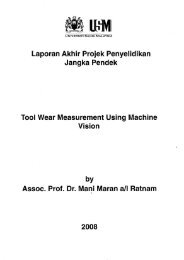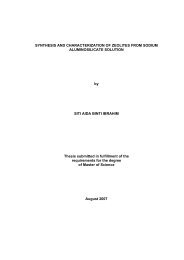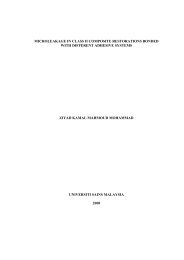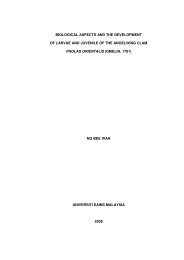design and development of a secure wireless ... - ePrints@USM
design and development of a secure wireless ... - ePrints@USM
design and development of a secure wireless ... - ePrints@USM
You also want an ePaper? Increase the reach of your titles
YUMPU automatically turns print PDFs into web optimized ePapers that Google loves.
Security <strong>and</strong> confidentiality <strong>of</strong> the sensitive medical data are <strong>of</strong> paramount<br />
importance to both patient <strong>and</strong> health care provider. Access to the data by the<br />
provider should only be granted with the patient’s consent except in emergency<br />
cases. To implement this idea, Marschollek <strong>and</strong> Demirbilek (2006) <strong>design</strong>ed a<br />
system which provides access to patient-related data in a distributed<br />
environment using a st<strong>and</strong>ard smart card. The card itself only holds basic<br />
information about the patient’s identity <strong>and</strong> some emergency data that can be<br />
made available immediately. The patient holds the key to this information in the<br />
form <strong>of</strong> a smart card <strong>and</strong> the PIN without which the health care provider cannot<br />
gain access to the central data base. They used st<strong>and</strong>ard s<strong>of</strong>tware components<br />
<strong>and</strong> technologies in order to facilitate interoperability with multiple system<br />
platforms. The aim <strong>of</strong> the project was to use a st<strong>and</strong>ard microprocessor card to<br />
provide a technical solution for recording the patient data.<br />
Telemonitoring involves home monitoring <strong>of</strong> symptoms <strong>and</strong> vital signs using<br />
special devices linked to telephone lines or internet cables. This technology<br />
may be particularly valuable in heart failure, because close supervision may<br />
reduce hospital admissions <strong>and</strong> accelerate discharge. In this manner Louis et<br />
al. (2003) collated published studies on the effectiveness <strong>of</strong> telemedicine in the<br />
management <strong>of</strong> heart failure. The authors included 18 observational studies <strong>and</strong><br />
six r<strong>and</strong>omised controlled trials with between 20 <strong>and</strong> 218 participants (mean<br />
age in the different studies ranged between 53 <strong>and</strong> 74 years whilst mean followup<br />
age ranged between 3 <strong>and</strong> 18 months). They observed that patients readily<br />
accepted <strong>and</strong> adhered to telemonitoring.<br />
15

















